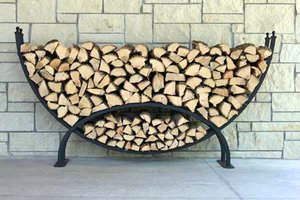Before picking up the phone, it’s important to know exactly what you want to purchase so that you can clearly express that to the wood seller, says Matt Galambos, a Maine arborist certified by the International Society of Arboriculture. This includes determining the quantity, species, and condition of the firewood, all of which affect its price.
How much to buy
Homeowners who intend to heat their homes through the use of a wood stove naturally will require more firewood than those who burn only the occasional fire for pleasure. A person living in the Northeastern U.S. who burns firewood as his or her primary heat source, for example, may require up to five cords of wood to get them through the season. In contrast, a weekend-only fire builder can likely get by on as little as a half-cord. Galambos estimates that for the casual but steady fire builder, one cord of wood should easily last through winter.
Measuring a cord of wood
A cord of wood is defined as a stack of cut firewood that measures 4 feet tall by 4 feet wide by 8 feet long, or any other arrangement that equals 128 cubic feet. The individual pieces must be stacked side by side rather than the looser crisscross style. Other measurement terms, such as ricks, racks, face cords and piles, have no legal meaning and are often banned by state weights and measurements agencies. Regardless what the load is called, says Galambos, it should always be converted to cords or fractions thereof so that homeowners can determine if they are getting a fair price.
Seasoning the wood
Freshly cut wood is composed largely of water. Not only is this “green” wood difficult to ignite, but burning it can lead to a dangerous buildup of creosote, the cause of chimney fires. Properly “seasoned” firewood is wood that has been cut to length, split, and allowed to air dry for at least six months until the moisture content dips to around 20%. Dry wood will appear grayish in color and the pieces will begin to exhibit splits and cracks on the ends. Compared to freshly cut wood, seasoned wood feels light for its size.
Though seasoned firewood is the only choice for immediate use, green wood shouldn’t be completely ignored, says Galambos. “If you have the room to store it and the time to dry it, buying green firewood can save you up to 25% compared with seasoned wood,” he says.
Hardwood vs. softwood
It’s a common misconception that burning soft woods, such as pine and cedar, leads to dangerous creosote buildup. As long as the firewood is properly seasoned, it can safely be burned in a fireplace or stove regardless of species, says Dr. John Ball, Professor of Forestry at South Dakota State University. But that doesn’t mean that all wood is created equal.
“Tree species differ widely in the amount of heat they produce when burned,” says Ball. Hardwoods like oak, maple, and madrone produce almost twice the heat compared with softer woods, such as spruce, pine, and basswood. Fires built with hardwood not only burn hotter, they last longer, meaning the wood pile won’t get depleted as fast. Homeowners can expect to pay a premium for 100% hardwood, but Ball cautions against purchasing cheaper “mixed-wood” loads that may contain little actual hardwood.
Storing firewood
Homeowners should consider storage long before the firewood delivery truck appears in the driveway, cautions Galambos. A cord of wood takes up a significant amount of space, and if not properly stored your investment will quickly begin to rot. Firewood that is not stowed in a protected space like a garage or shed needs to be six inches off the ground. Firewood racks or simple pallets work well. If exposed to the elements, the wood pile should be at least partially covered with a waterproof tarp. Experts caution against storing the wood too close to the house for fear of inviting pests.
Average prices
Homeowners can expect to pay $75 to $150 for a half-cord and between $150 and $350 for a cord of hardwood delivered and stacked. To save some money, a person with a large truck may elect to pick up his or her own load at the wood lot.
To verify the quantity, species, and condition of the firewood, it’s wise to arrange the delivery for a time when you’re home. Experts say, inspect the wood for type and condition before it’s unloaded, though quantity can only be accurately measured after it’s stacked.
Maximize your fireplace efficiency
It’s true that a traditional wood fireplace can never rival the energy efficiency of a wood stove or even a fireplace insert, but there are ways a homeowner can trim heat loss. Fire-resistant glass doors not only reduce the volume of heated home air that escapes up the chimney, they help radiate heat back into the room. Similarly, a thick cast-iron fireback is an old-fashioned device that absorbs and emits energy in the form of radiant heat. Check the fireplace damper for leaks and always tightly seal it when the fireplace is idle.




















